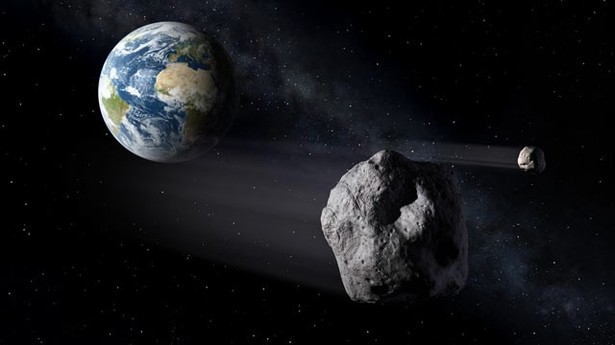More observations are planned over the next few days, including using the Arecibo radio telescope which will provide higher-resolution data. Mind you, the radar data is a bit weird. It’s not showing you an actual picture of the asteroid. The vertical axis is showing distance to the asteroid—if there’s a hill you’d see it poke up toward the top, and a crater would be a depression. The horizontal axis, though, is actually the velocity at which the asteroid is spinning. The faster the rock spins, the more smeared out it is left-to-right; one that doesn’t spin at all would look like a vertical line. I know, it’s weird, but it’s the way this kind of radar observation works. Not only that, but we’re illuminating it with the radar pulses, so when you look at the picture or video, it’s like the radio telescope is off the top of the frame, shining down on the asteroid. Imagine holding an orange in one hand and a flashlight in the other; you’re illuminating one side, not the whole thing. Radar reflections are strongest from the point on the asteroid directly under the radar beam, so that becomes the bright edge in the image. The reflections tend to get weaker near the edge, so it fades toward the bottom, giving it that odd crescent shape. The moon looks curiously bright in the radar imagery, but I’m not sure why; I haven’t heard any comments about this yet—that may simply be because it’s small, so we don’t see it fade as much toward its edges like we do in the bigger rock. Think of it like having all its light compressed into fewer pixels, so each pixel is brighter. –Slate
If a dangerous asteroid appears to be on a collision course for Earth, one option is to send a spacecraft to destroy it with a nuclear warhead. Such a mission, which would cost about $1 billion, could be developed from work NASA is already funding, a prominent asteroid defense expert says. Bong Wie, director of the Asteroid Deflection Research Center at Iowa State University, described the system his team is developing to attendees at the International Space Development Conference in La Jolla, Calif., on May 23. The annual National Space Society gathering attracted hundreds from the space industry around the world. An anti-asteroid spacecraft would deliver a nuclear warhead to destroy an incoming threat before it could reach Earth, Wie said. The two-section spacecraft would consist of a kinetic energy impactor that would separate before arrival and blast a crater in the asteroid. The other half of the spacecraft would carry the nuclear weapon, which would then explode inside the crater after the vehicle impacted. The goal would be to fragment the asteroid into many pieces, which would then disperse along separate trajectories.
Wie believes that up to 99 percent or more of the asteroid pieces could end up missing the Earth, greatly limiting the impact on the planet. Of those that do reach our world, many would burn up in the atmosphere and pose no threat. Wie’s study has focused on providing the capability to respond to a threatening asteroid on short notices of a year or so.
The plan would be to have two spacecraft on standby — one primary, the other backup — that could be launched on Delta 4 rockets. If the first spacecraft failed on launch or didn’t fragment the asteroid, the second would be sent aloft to finish the job. –Space
http://theextinctionprotocol.wordpress.com/2013/05/31/nuclear-detonation-the-best-way-to-deflect-threatening-asteroids-say-experts/

 RSS Feed
RSS Feed